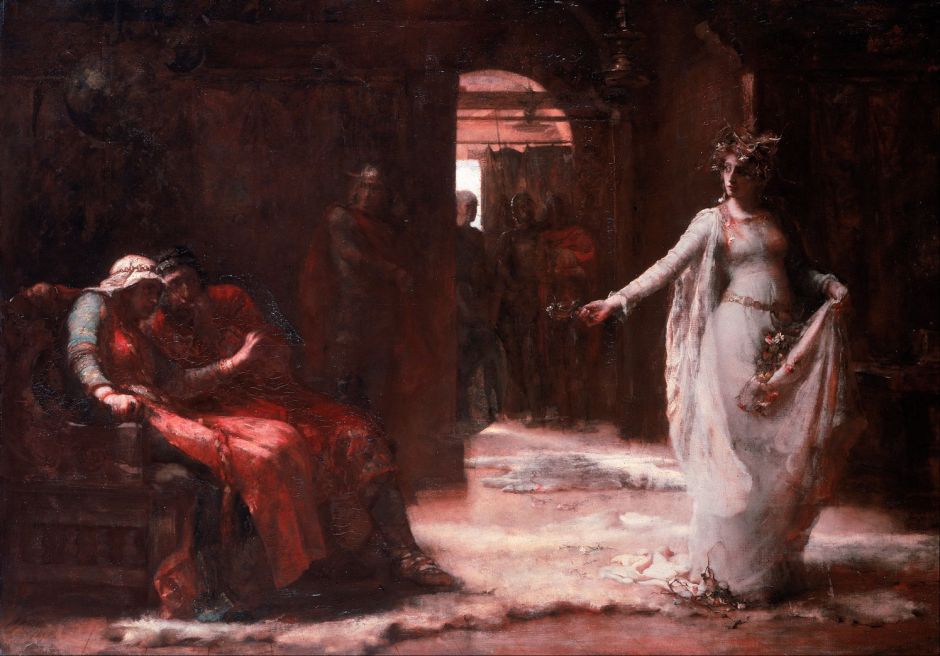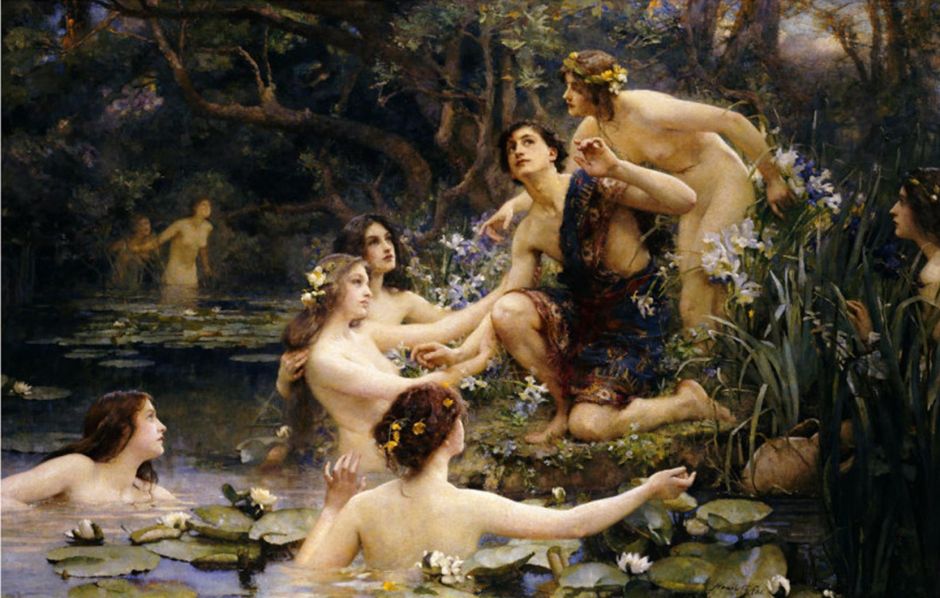For a long time, women artists, no matter how successful, were prohibited from attending life classes. Indeed, with the strict moral codes of the late nineteenth century, painters such as Thomas Eakins found themselves being ostracised for encouraging the use of nude models. One of those who broke down the barriers was Henrietta Rae (1859–1928), whose paintings of nudes finally became socially acceptable.
She was born in London, and was a precocious artist who attended private art schools until finally gaining admission to the Royal Academy Schools in 1877, where she was taught by Frank Dicksee, William Frith, and Lawrence Alma-Tadema. Her early work was fairly conventional, and she started to exhibit at the Royal Academy in 1880 (or 1881), showing portraits and narrative works at first.
In 1884 she married Ernest Normand, a painter who even The Times reluctantly admitted was not as good as she was, and the couple lived in Kensington, London, adjacent to Val Prinsep and Frederick, Lord Leighton, who became her mentor. Henrietta was unconventional in continuing to work under her maiden name.

A Bacchante (1885) was the first of her nudes to be exhibited at the Royal Academy. The alabaster-like skin and classical setting make it academic rather than erotic, and the thyrsus (staff) held in the left hand and bunch of grapes in the right seem to have made all the difference to the hanging committee. It still caused quite a stir, and Henrietta was offered unsolicited advice not to show such works in public again. She thankfully ignored them.

Doubts (1886) seems something of a ‘problem picture‘, which may have been more biting social comment. A young woman sits on a garden bench, clearly in a quandary. Behind her, forcing his attentions on her, is an older man who is dressed as a tasteless fop. Around her are the signs of his attempts to charm her, with baskets of flowers. The ring finger on his left hand is already occupied, suggesting that he may even be proposing an adulterous relationship.

Zephyrus Wooing Flora (1888) is a delicate ‘faerie’ painting of a far less wholesome classical myth, part of the reading of Botticelli’s renowned Primavera (Spring). In Ovid’s version in his Metamorphoses, Zephyrus abducted the nymph Chloris or goddess Flora, and Botticelli shows the metamorphosis of Chloris into Flora as a result of that abduction.

I regret that Henrietta’s painting of Ophelia (1890) is shown poorly in this image, but I have been unable to find any better colour version. It shows Ophelia, from Shakespeare’s tragedy Hamlet, when she has become mad from grief. In Act 4 Scene 5, she scatters flowers and herbs while reciting their names and symbols in front of King Claudius and Queen Gertrude, as shown here:
There’s rosemary, that’s for remembrance. Pray you, love,
remember. And there is pansies, that’s for thoughts.
There’s fennel for you, and columbines. There’s rue for you,
and here’s some for me. We may call it herb of grace o’ Sundays.
O, you must wear your rue with a difference! There’s a daisy. I
would give you some violets, but they wither’d all when my father
died. They say he made a good end.
For bonny sweet Robin is all my joy.
In 1890, the family moved to Paris, where Henrietta studied at the Académie Julian under Jules Joseph Lefebvre and Jean-Joseph Benjamin-Constant, and gained experience of Impressionism and its artists. She decided not to alter her style, and remained firmly committed to the salon style of Prinsep, Leighton, and others.

Miss Nightingale at Scutari, 1854 (1891) is a chromolithograph of what was probably her best-known painting, showing the pioneer nursing performed by Florence Nightingale in the Crimean War, giving rise to Nightingale’s epithet of the lady of the lamp. Numerous other artists featured her in their works, usually in similar settings.

Henrietta also painted her version of Mariana (1892), a motif which I examined earlier. She clearly opts for Tennyson’s account, and appears to be alluding to Marie Spartali Stillman’s painting of 1867, with its bottle-glass windows, although her composition looks original.
In 1893, the family moved to Upper Norwood, London, where they remained until her death. She was awarded medals at the World’s Columbian Exposition in Chicago in 1893, and in Paris.

She intended her huge painting of Psyche Before the Throne of Venus (1894) to be her masterwork, but when it was exhibited at the Royal Academy the critics were belittling and misogynist, one calling it “a glorified Christmas card”, so dashing her aspirations. She was successful in selling it, though.
In 1897, she organised an exhibition of the work of women artists to commemorate Queen Victoria’s jubilee, and in 1900 she was commissioned to paint a large mural for The Royal Exchange in London.

Spring (c 1900) is altogether less narrative, and rather looser in the brushwork of the flowing fabric.

The Sirens (1903) marked her return to narrative works featuring classical nudes. Showing a well-known scene from Homer’s Odyssey, Odysseus’ ship is in the distance, as the three beautiful sirens use their pipes and lyre to lure the occupants to their deaths. Henrietta’s brushwork has become more vigorous and in parts gestural. This painting was shown at the Saint Louis Exhibition in 1904, where it sold to a collector from Philadelphia.

In the early twentieth century, frustrated by its lack of success, Henrietta made at least two paintings based on the centrepiece of her earlier Psyche Before the Throne of Venus. This is the derivative Venus Enthroned of 1905.

A second was her Roses of Youth, from around the same time.

Although now little-known, the story of Hylas and the Water Nymphs (c 1909) had been popular, for instance being the subject of a painting by JW Waterhouse in 1896. Hylas was arms-bearer to Heracles, and one of the Argonauts. When he visited the spring of Pegae (Dryope), he was kidnapped by nymphs. Unable to find him, Heracles and the other Argonauts set sail without him, and he was abandoned to his fate with them. This painting was exhibited at the Royal Academy in 1910.

Spring’s Awakening (The Snow Maidens) (1913) was one of Henrietta’s late paintings, showing three nymphs emerging from snowdrops and ground mist as a symbol of the arrival of spring. The nymphs are listening to birdsong, with several small birds visible on the branches in the foreground.
I am surprised that there does not appear to have been any recent monograph about Henrietta Rae’s life and paintings, given her success and extensive relationships with other leading artists of the day.
References
Arthur Fish (1905) Henrietta Rae (Mrs. Ernest Normand), Cassell and Co. Available free at archive.org.

